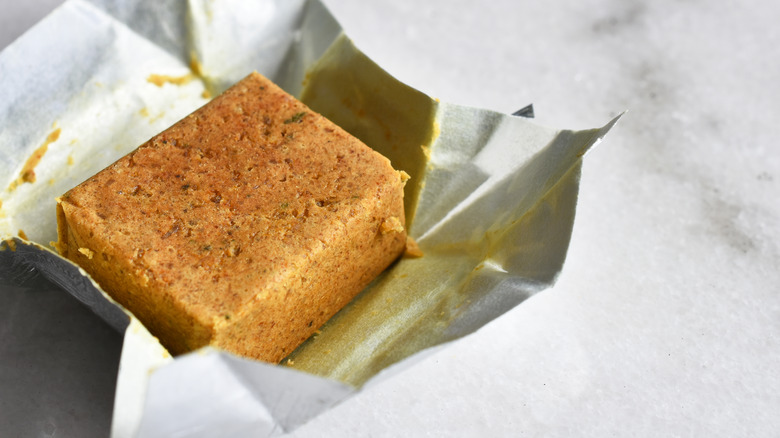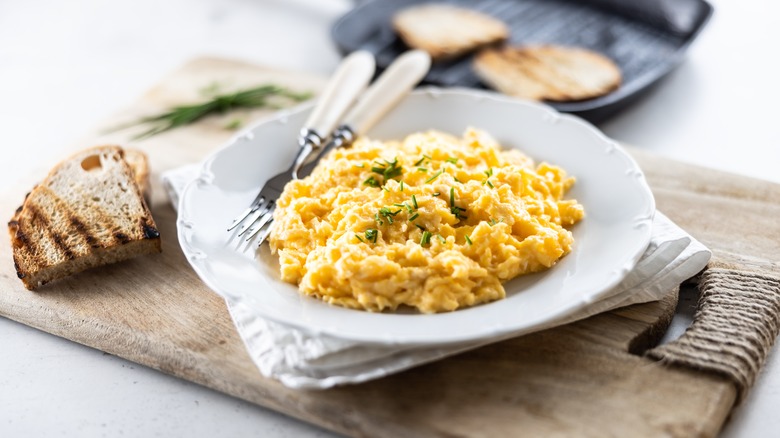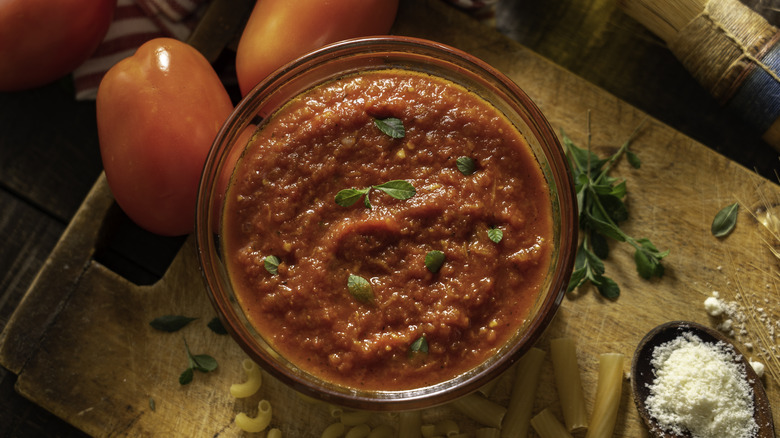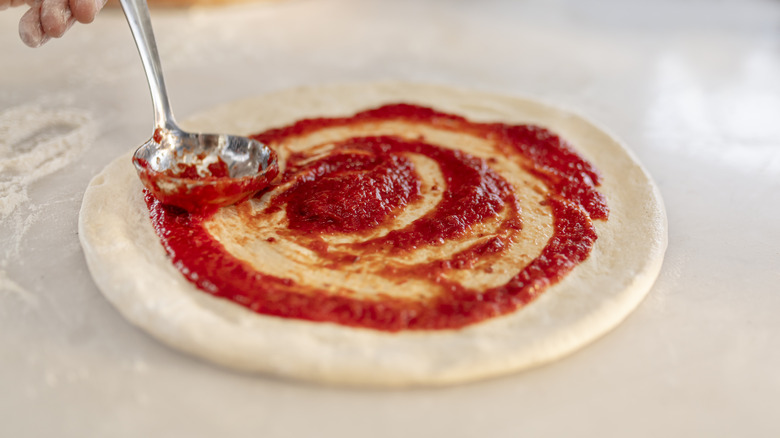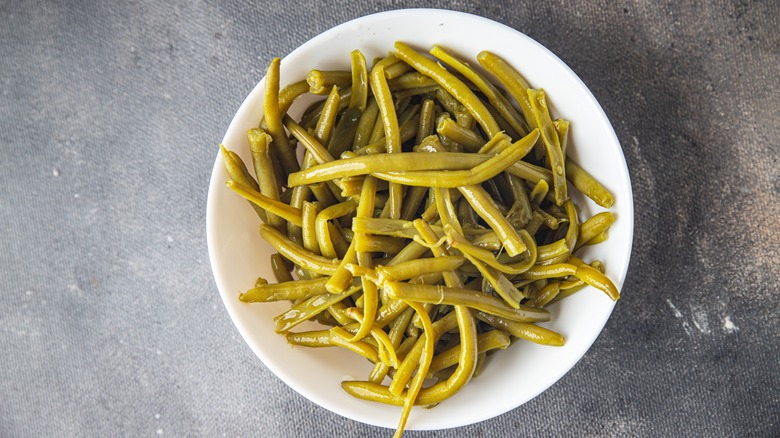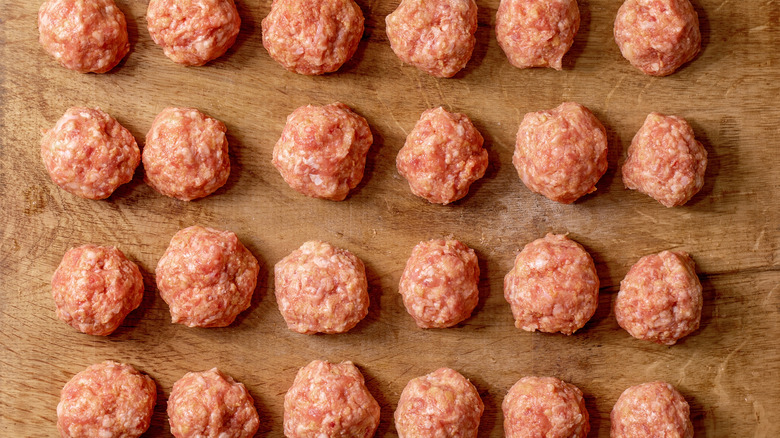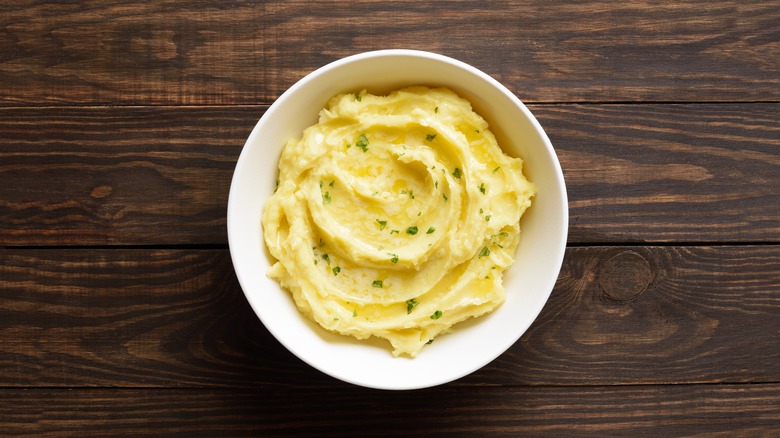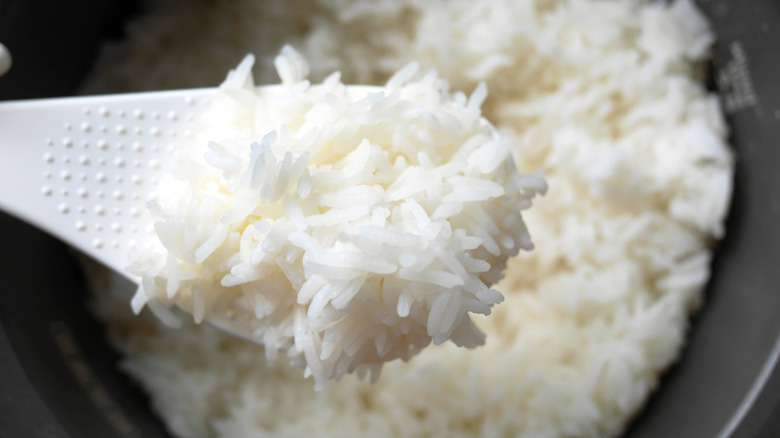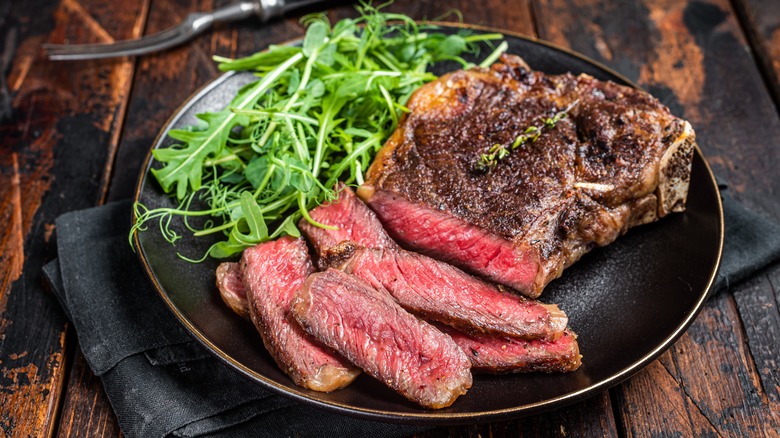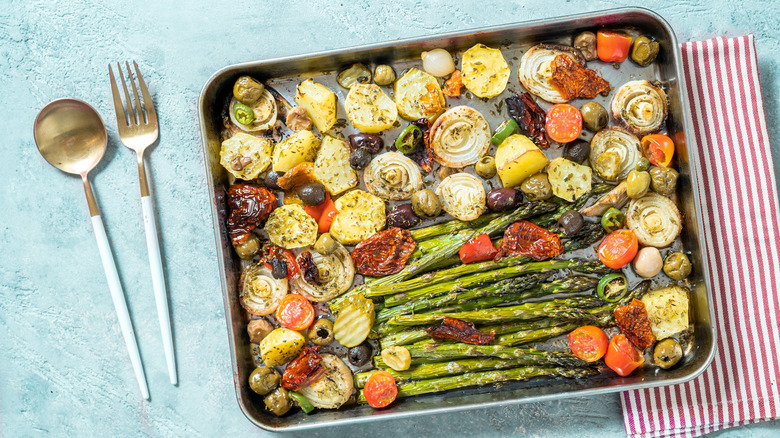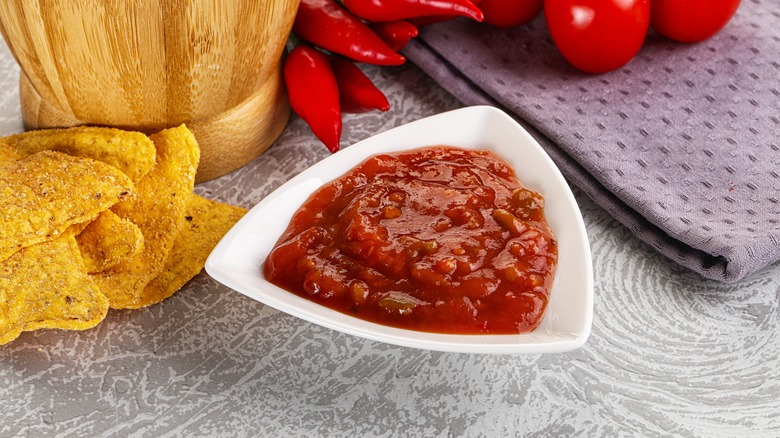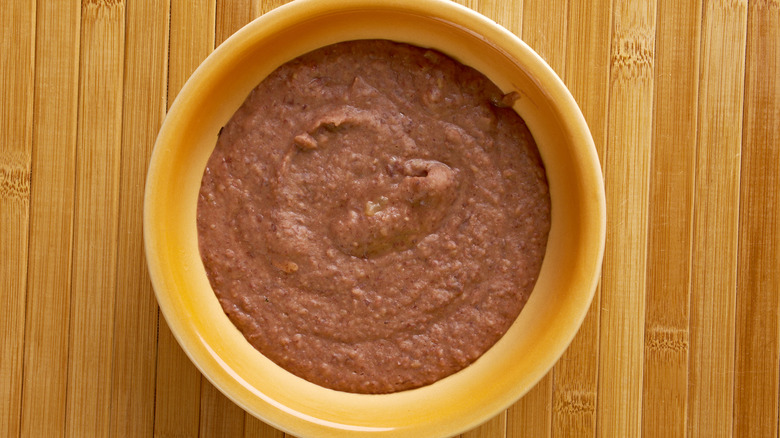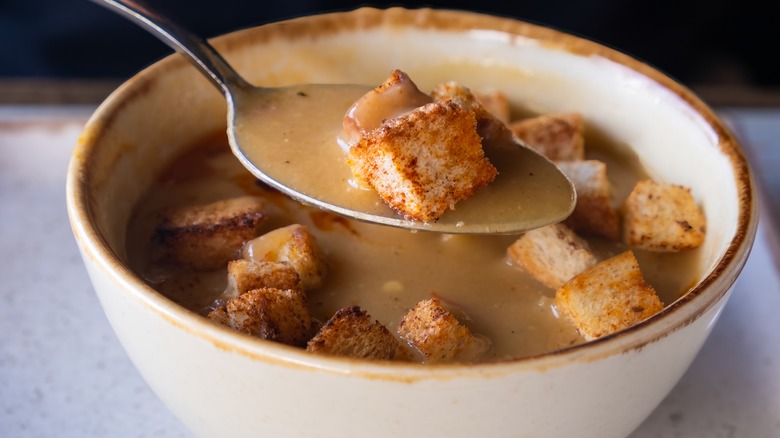14 Foods You Can Upgrade With Bouillon Cubes
Bouillon cubes changed the game. These shelf-stable, easy-to-use cubes made bouillon, an ingredient with some surprising colonial European origins, readily available to the masses. Pioneered by the Swiss Maggi corporation, which made the cubes widely available in 1908, bouillon has a place in almost every cuisine around the world, and its ability to add instant flavor to meals has made it a must-have pantry item. What might surprise you about bouillon cubes, though, is just how versatile they are. While everyone knows they can be used in lots of different dishes, most of us reserve them for our soups, stews, and sauces, and the truth is that they can add flavor to everything from eggs to salsa.
Bouillon cubes get their flavor from a concentrated mixture of seasonings, dehydrated meat or vegetables, and salt. They also often contain monosodium glutamate, which gives them a savory flavor. This combination of ingredients can add intensity to a host of dishes, and their dry nature means that they can often be added to recipes like meat rubs. They can even be used as a seasoning mix in their own right — employed to coat snacks like popcorn or inject flavor into meatballs. If you're ready to see just how versatile they are, grab your cubes and let's get started.
1. Scrambled eggs
What do you put in your scrambled eggs? A little salt and pepper and a dash of milk, perhaps? Purists will tell you that's all you need (some folks may even claim that all you require are eggs). However, if you want to make this meal taste punchy and rich, spice eggs with a dash of bouillon powder. The seasoning can add intense flavor to your scrambled eggs and give them a strong undertone of umami that stops them from being too creamy and insipid. Due to its richness, using bouillon eliminates the need for salt or pepper.
Plus, bouillon cubes do all this without introducing any additional moisture, meaning that your eggs remain bulky, bouncy, and firm. For an easygoing, subtle flavor, use chicken or vegetable bouillon. If you want something a bit more punchy, you can use a beef bouillon cube, but bear in mind that this may introduce a darker tone to your eggs. Importantly, make sure you use less than you think. Bouillon cubes can be incredibly salty, and you probably won't know that you've added too much until they've cooked, given that you likely won't want to taste your eggs before tipping them into the frying pan.
2. Pasta sauce
Making a good pasta sauce can be tougher than it looks. While some folks will tell you that all you need are juicy tomatoes and some basic seasonings, more often than not, simple pasta sauces can end up bland and lack body. Therefore, if you want to beef up your pasta sauce without adding any meat, use a bouillon cube. Bouillon provides a rich, savory flavor without changing the consistency of your sauce, allowing the harmony of pasta and sauce to remain intact.
If you're using bouillon cubes in your sauce, make sure you crumble them up really well. Some bouillon cubes can have trouble dissolving, and you may end up with a chunk of intensely salty flavor lurking somewhere in your sauce. You should also remember that pasta sauce, like all sauces, will concentrate the longer it cooks as its moisture evaporates. So, don't be afraid to taste your sauce regularly to check the intensity of its flavor. If you find that your bouillon cubes add too much saltiness, thin out your pasta sauce with a little water or some more crushed tomatoes (remembering to cook them once you've added them, of course).
3. Popcorn
We don't know about you, but we can get pretty bored of popcorn. This isn't helped by the fact that, more often than not, it can be pretty bland when you make it at home. Homemade organic popcorn doesn't have any of that flavor punch that the store-bought kind does, and it can feel like just adding salt to it can leave it somewhat underpowered. That's why TikTok went wild when it was revealed that chicken bouillon can serve as an incredibly flavorful base for popcorn, where it delivers saltiness, savoriness, and an herbal note.
@chefreillymeehan Con sabor de pollo or GTFO.#popcorn#hacks#kitchenhacks
You can use chicken bouillon on its own by crushing a cube and sprinkling it over your popcorn or combine it with pretty much any flavor you like. Try pairing it with some black pepper and grated parmesan, or go ultra-fancy and add some shaved truffles. When using bouillon, make sure that you give it something to cling to. You'll need to coat your popcorn with a little oil or butter (or a butter-flavored oil) so that it sticks to each kernel and doesn't just fall to the bottom of your bowl.
4. Pizza
Using a bouillon cube to make pizza? Yes, it's a thing, and it's delicious! Adding chicken bouillon to your pizza's tomato sauce can give it a huge amount of flavor and a base of savoriness that complements virtually any topping you choose. The best part is how quick this combination is to whip up: Just add a cube or two of chicken bouillon (depending on your taste) to a can of tomatoes and simmer the mixture for five minutes.
When using bouillon in your pizza, we would always recommend trying to keep your toppings simple and low in sodium. Opting for salty meats like salami or pepperoni may seem delicious, but you'll end up with an incredibly salty, nearly inedible pie. Instead, go for a low-sodium mozzarella and some chopped veggies like peppers and onions. You may also want to offset the saltiness with some sweet notes: A drizzle of honey on top of your pizza (or added to your pizza dough) can stop things from getting too briny.
5. Green beans
When they're good, green beans can be crunchy, zesty, and delicious — but when they're bad, they're pulpy, tasteless, and vaguely chalky. This is a particular problem with canned green beans, which seem to have their flavor sapped from them the moment they enter the tin. Luckily, if you want to upgrade your canned green beans, a simple bouillon cube is the answer. You merely have to dissolve your cube and then simmer your green beans in the bouillon until they're flavorful and juicy. If you want a lighter, slightly fresher taste, go for chicken bouillon or use beef bouillon for a meatier, deeper effect.
The best thing about using a bouillon cube is that you can control the intensity of the broth. If you don't want your beans to be too salty (or if they already have sodium added to them), use half a cube or water it down more than you normally would. If you want more flavor, use a higher bouillon-to-water ratio. For pure, concentrated umami, you can even just sprinkle a crushed cube straight onto your green beans as an alternative to seasoning salt. Just bear in mind that doing this will make your beans pretty salty, so do so sparingly.
6. Meatballs
There's nothing quite like meatballs, but no experience is as disappointing as consuming a flavorless one. Unfortunately, that can be pretty common. Meatballs can often be underpowered and lack that meatiness that you (quite rightly) expect from them. Using store-bought bouillon cubes to elevate meatballs will help you avoid any blandness. Just crush your bouillon cubes, sprinkle them into your meat mixture, and stir to combine. Your meatballs will gain instant savoriness and salt, as well as flavor notes from the dehydrated meat and any herbs and spices in the recipe.
Moderation is key here, as you won't be able to taste your batch of meatballs until they're fully cooked. One way to get a sense of how your bouillon cubes have affected your meatballs, though, is to make a tester. Take a small portion of your meat and make a small meatball or patty out of it, frying it in a pan. If it tastes underseasoned, you can add some more bouillon. If it's too salty, you can add some more meat or breadcrumbs to balance things out. Try not to do this too many times, as the more you mix your meat, the more it'll toughen.
7. Mashed potatoes
Mashed potatoes are a dish that lives and dies by its seasoning. Add too little to your mash, and it'll be excruciatingly bland and deeply disappointing. While salt and pepper can do the trick, we prefer to upgrade mashed potatoes with a little bouillon. Crushing a cube and tipping it directly into the potatoes is a quick way to give them immediate umami and depth without introducing too much moisture.
If you're looking to loosen up your mashed potatoes, you can also dissolve your cube in a little water and pour it in until it's the perfect consistency. We'd always recommend using chicken or vegetable bouillon cubes for mash due to their pale color and slightly lighter flavor. Using beef will make the potatoes too brown, which probably isn't what you want. Chicken bouillon goes especially well with the dairy notes from milk, cream, or butter. Just bear in mind that some types of salted butter will add a surprising amount of sodium to mash, and if you're then adding bouillon, things can get way too briny in no time. As always, the key is to taste test frequently.
8. Rice
It's time that rice became the main event. This staple accompaniment to countless foods is usually pretty neutral (which is why it goes so well with anything you care to serve it with), but by adding a bouillon cube to it, you can turn it into the showstopping element in your meal. Bouillon infuses rice with a distinctive savoriness that works terrifically with its delicate, fragrant flavor. Chicken and vegetable bouillon also give it a herbal, slightly floral note and a light, yellow tinge that makes it look way more appealing.
Adding a bouillon cube to rice is as simple as crushing it into the water to cook rice. You'll generally need one cube per 2 cups of water, although certain brands may have different ratios. If you don't want your rice to be too salty (which we definitely don't recommend, as it'll just overpower every other flavor on your plate), try using more water and less bouillon. You don't have to keep things simple, either. A bouillon and rice combo can serve as the base for countless other meals, from risotto to jambalaya, where you can throw in pretty much anything you want.
9. Steak rub
Getting the flavor right on your steak can be harder than you think. For beef to really pop, it needs an ample amount of seasoning and way too many people just don't add enough, leaving the meat underwhelming. You can avoid this by making bouillon a key part of your steak rub. Beef bouillon has a highly concentrated beef flavor, and when it's added to steak rubs, it amps up the depth and savoriness of your meat while also helping it sear.
It's almost astonishing how easy it is to use bouillon as a steak rub, too. Just crumble up a cube and mix it with olive oil before rubbing it generously and vigorously onto your meat. Leave it for a few minutes to allow the flavors to meld with the beef before throwing it into your pan. Because beef bouillon can be flavored with herbs and spice, there's no need to add anything else into the mix if you don't want to. However, you can totally throw in your favorite seasonings alongside the bouillon — it serves as a fantastic base for pretty much any flavor you want.
10. Beer batter
When you think of making beer batter, you likely don't think of adding bouillon to it. However, we'd recommend you try adding it next time. Bouillon can add a huge amount of flavor to beer batters intended for chicken and fish and help to reinforce the protein's flavors while also seasoning the batter itself. The savoriness of the bouillon also balances the yeasty, slightly bitter notes of beer well, giving the batter a well-rounded taste instead of coming out too malty. Adding bouillon also rids you of the need to add salt — it's all in the mix.
Chicken bouillon is the best choice to add to beer batter, as it has a gentle savoriness that works surprisingly well with fish, as well as chicken. Having said this, you really don't want to go overboard here. If you crumble in too much, your fish will just taste like chicken, and will be too salty to boot. We'd also encourage you not to be tempted to dissolve your cube before adding it, as this can make the batter too runny.
11. Roasted vegetables
Adding flavor to roasted vegetables can be weirdly difficult. It's a fine balance between seasoning them well enough so that their inherent flavors are highlighted, but not making them taste too salty. A vegetable bouillon cube is your key to success. Vegetable bouillon infuses your roasted veggies with herby, salty, savory flavors that don't overwhelm the taste of your produce itself. Instead, it serves as a bed upon which the unique flavors of your vegetables can sit and be held up on.
The savoriness that's added by vegetable bouillon also helps to balance any sweet notes in your veggies, making them taste way more complex and complete. It's best to crumble the bouillon into olive oil and mix the two before adding it to your vegetables to avoid introducing moisture that might steam them. You can use virtually any vegetable that can be oven-cooked here – the world's your oyster. Then, roast them for about half an hour at 200 degrees Fahrenheit until each veggie is browned and fully cooked. From there, you can serve your bouillon-infused vegetables as a side dish or combine them with any pasta like orzo for a truly Mediterranean meal.
12. Salsa
If you've ever wondered why your salsa tastes so bland, it's probably because it's missing one key ingredient: Bouillon. Now, we totally get that this isn't a traditional addition, and it will probably raise a few eyebrows. Adding chicken or vegetable bouillon cubes to salsa, however, can lift it up in a seriously satisfying way. Bouillon gives salsa a more rounded flavor than salt can, making it taste way more fuller and richer. At the same time, it gently highlights the zesty, bright flavors of your onions, chiles, and tomatoes.
Importantly, though, we would only recommend adding bouillon to salsas that use cooked ingredients. Adding it to pico de gallo will detract from the freshness of your vegetables and make them taste weirdly artificial. Instead, add a small amount of crumbled bouillon to blended salsas made from roasted vegetables to give them a fuller flavor profile. As always, be cautious, as too much will make the salsa overly salty. And if you don't want to add any extra moisture to it, it'll just make your sauce too slack.
13. Refried beans
Trying to make refried beans taste good without throwing in handfuls of salt and hoping for the best is pretty difficult. The key is adding some bouillon. Chicken bouillon gives you the saltiness you need with an umami punch that offers your beans a much richer flavor. As a result, the dish tastes way more substantial while still retaining the main nutty note from the beans.
Chicken bouillon also pairs seamlessly with the classic aromatics that go into refried beans, like cumin, onion, and garlic, and helps to highlight their individual flavors and aromas. You can add bouillon to virtually any refried beans recipe you're using in place of salt. If you're making a slow cooker version, simply mix it into your water to make a flavorful broth. If you prefer a more traditional approach, you can sprinkle some dried bouillon toward the end of the cooking process or splash some dissolved bouillon in to loosen the beans. Don't be shy here: Your beans will need a fair amount of seasoning to taste good.
14. Croutons
There's nothing quite like a crunchy, salty crouton. Whether placed on top of your salad or dunked into soup, croutons provide crucial textural variety and the all-important intense flavor – provided they've been seasoned properly. The secret to doing this is using a bouillon cube. Whether you're opting for chicken or vegetable bouillon, a crumbled cube can add incredible amounts of flavor to the crust of your croutons.
For the best result, we'd advise trying to find the driest bouillon cube possible. Softer bouillon cubes may not crumble as well, and what you want here is that dry, powdery, almost sand-like consistency. While the basic bouillons work well, opting for a fancier bouillon flavored with herbs or roasted garlic can give croutons even more flavor. If you can't find those, though, don't be afraid to mix your favorite herbs or seasonings, like garlic and onion powder, into your bouillon mix. You want your croutons to taste powerful and concentrated, so in our opinion, the more the merrier! Just ensure that you're not adding any extra salt: The bouillon will do all the work on that front.
